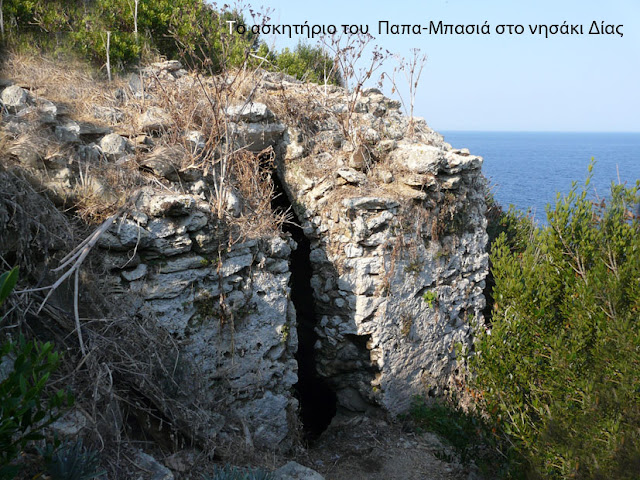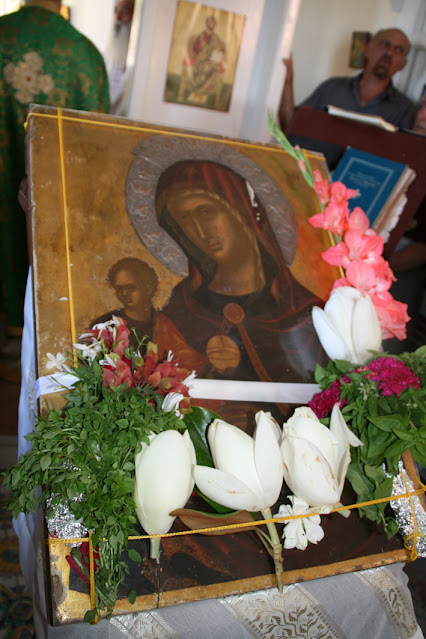Steep on all sides and imposing, it has been described by Professor Spyros Marinatos as “the Meteora of the sea”. It was named Dias because in ancient times, on the rocky islet there was an altar of the god Zeus.
There is a reference in Hesiod about this islet that, at the top of Aenos in Kefallonia, there was a Temple of the God Zeus, where traces and many relics of sacrifices had been found, which were saved until 1813. When the priests on Aenos sacrificed the sacred carcasses on the altar of Zeus, the smoke that rose to the sky gave the "sign" and the ceremony of a second, almost simultaneous sacrifice began on the rocky islet of Dias, which is in line of sight with Megalo Soros (the highest peak of Aenos). When the priests saw the second column of smoke, they understood that the sacrifice to Zeus had been completed.
The rocky islet of Dias during the British rule was a place of exile for clergy, for spiritual and political reasons. Many priests, on the occasion of the measures imposed by the English, opposed and were accused of seeking popular uprisings against the English authority. In fact, in a specific issue of civil law, which had to do with the chronological system of registry acts, and was the subject of the Church, many priests resisted. The priests of Lixouri resisted very vigorously and were exiled to Dias and Vardiani as punishment.
On the islet of Dias, it is unknown when and by whom, the small Monastery of Panagia of Blachernae was founded. The monastery's income was minimal and it was supported by the alms of Christians. Records show that there were three monks who lived there in 1805 and three in 1889.
At the beginning of the 19th century, an exiled priest from Zakynthos lived there for a long time. His name was Nikolaos Kantounis. The priest Nikolaos Kantounis was an iconographer, and he painted the small chapel. The presence of the Zakynthian priest in Dias makes us believe that the exiles were not limited to Kefallonia, but very likely also from the other Ionian Islands. Another priest, N. Dracontaeidis, went to Dias and stayed there for several months where he maintained and looked after the monastery. He is responsible for the construction of the stone staircase of one hundred steps, and the small pier.
In 1867, after a terrible earthquake, the monastery suffered great damage. Then the Lixouri priest N. Dracontaeidis appealed to Metropolitan Spyridon Kontomichalos and asked for his help in repairing it. After the priest's urgings, the Metropolitan sent the steward priest Makarios Fragatos to collect help in order to repair the damage. The sums collected were sufficient, mainly from the Kefallonians who lived outside Kefallonia, and thus the repairs were made.
Saint Panagis Basias from Lixouri also stayed for a long time in Dias beginning in 1821. At that time he was a teacher, when the Ionian islands were under British rule, and they wanted him to teach Protestant doctrines to the students instead of Orthodox teachings, so he resigned from his position and went to live as a hermit on Dias.
In 1953 the monastery was demolished again by the devastating earthquake that struck Kefallonia. However, the Chapel of the Theotokos of Blachernae was built, at the expense of the Spartan Doctor Marinos Vallianos, consecrated in 1963 and exists to this day.
The Chapel of the Theotokos of Blachernae, otherwise known as Panagia Diotissa, as the locals call it today, celebrates on July 2. On this day, the Orthodox Church celebrates the Deposition of the Robe of our Panagia in Blachernae of Constantinople.
The icon of the Panagia is kept in the Church of the Crucified in Pessada. The festival of the Panagia Diotissa is held regularly even today, every July 2. With a boat, ships and other vessels, the sea procession of the icon begins, from the port of Pessada, and the boats of the Spartans join along the way (at least this is how it was once done), to then arrive at the chapel of Dias where the Divine Liturgy will be held. After the Divine Liturgy, there is a procession of the icon on the island, from the church to the existing well.
There is a reference in Hesiod about this islet that, at the top of Aenos in Kefallonia, there was a Temple of the God Zeus, where traces and many relics of sacrifices had been found, which were saved until 1813. When the priests on Aenos sacrificed the sacred carcasses on the altar of Zeus, the smoke that rose to the sky gave the "sign" and the ceremony of a second, almost simultaneous sacrifice began on the rocky islet of Dias, which is in line of sight with Megalo Soros (the highest peak of Aenos). When the priests saw the second column of smoke, they understood that the sacrifice to Zeus had been completed.
The rocky islet of Dias during the British rule was a place of exile for clergy, for spiritual and political reasons. Many priests, on the occasion of the measures imposed by the English, opposed and were accused of seeking popular uprisings against the English authority. In fact, in a specific issue of civil law, which had to do with the chronological system of registry acts, and was the subject of the Church, many priests resisted. The priests of Lixouri resisted very vigorously and were exiled to Dias and Vardiani as punishment.
On the islet of Dias, it is unknown when and by whom, the small Monastery of Panagia of Blachernae was founded. The monastery's income was minimal and it was supported by the alms of Christians. Records show that there were three monks who lived there in 1805 and three in 1889.
At the beginning of the 19th century, an exiled priest from Zakynthos lived there for a long time. His name was Nikolaos Kantounis. The priest Nikolaos Kantounis was an iconographer, and he painted the small chapel. The presence of the Zakynthian priest in Dias makes us believe that the exiles were not limited to Kefallonia, but very likely also from the other Ionian Islands. Another priest, N. Dracontaeidis, went to Dias and stayed there for several months where he maintained and looked after the monastery. He is responsible for the construction of the stone staircase of one hundred steps, and the small pier.
In 1867, after a terrible earthquake, the monastery suffered great damage. Then the Lixouri priest N. Dracontaeidis appealed to Metropolitan Spyridon Kontomichalos and asked for his help in repairing it. After the priest's urgings, the Metropolitan sent the steward priest Makarios Fragatos to collect help in order to repair the damage. The sums collected were sufficient, mainly from the Kefallonians who lived outside Kefallonia, and thus the repairs were made.
Saint Panagis Basias from Lixouri also stayed for a long time in Dias beginning in 1821. At that time he was a teacher, when the Ionian islands were under British rule, and they wanted him to teach Protestant doctrines to the students instead of Orthodox teachings, so he resigned from his position and went to live as a hermit on Dias.
In 1953 the monastery was demolished again by the devastating earthquake that struck Kefallonia. However, the Chapel of the Theotokos of Blachernae was built, at the expense of the Spartan Doctor Marinos Vallianos, consecrated in 1963 and exists to this day.
The Chapel of the Theotokos of Blachernae, otherwise known as Panagia Diotissa, as the locals call it today, celebrates on July 2. On this day, the Orthodox Church celebrates the Deposition of the Robe of our Panagia in Blachernae of Constantinople.
The icon of the Panagia is kept in the Church of the Crucified in Pessada. The festival of the Panagia Diotissa is held regularly even today, every July 2. With a boat, ships and other vessels, the sea procession of the icon begins, from the port of Pessada, and the boats of the Spartans join along the way (at least this is how it was once done), to then arrive at the chapel of Dias where the Divine Liturgy will be held. After the Divine Liturgy, there is a procession of the icon on the island, from the church to the existing well.


 |
| Dias in 1930 |
 |
| Hut of Saint Panagis Basias in Dias |























